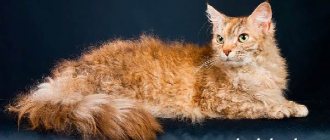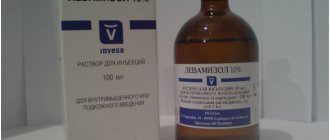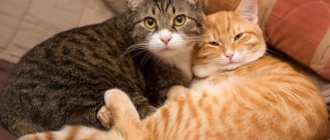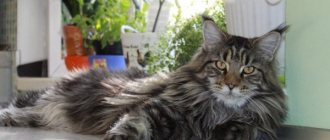Some people are prone to allergies. It occurs under the influence of various factors: food, plants, etc. Cats can also become provocateurs of a pathological condition.
Living in a house with mustachioed pets becomes impossible, especially if discomfort appears in a child. However, there is a way out of this situation: hypoallergenic cats.
Yavanese and Siberian
Causes of allergies
It is generally accepted that human allergies are associated with cat fur. But in fact, this is not always the case; often irritation of the skin and respiratory tract occurs due to the protein contained in saliva, cat urine, and animal epidermis.
Protein protein attaches to microscopic dust particles that settle on furniture and things. They penetrate into a person’s airways, causing a pathological condition: he sneezes, coughs. The patient suffers from itching and severe tearing.
Devon Rex and Peterbald
An allergic reaction manifests itself differently for everyone. It can occur not only due to protein, but also due to feces, saliva, urine, etc. It is impossible to predict whether a pathology will appear in a particular breed. To do this, you need to spend some time with the animal. If there is a predisposition to the disease, it is better to give preference to certain breeds of cats.
Animal for allergy sufferers
It is quite understandable that any person, even an allergy sufferer, would want to have a furry (or feathered or scaly) friend.
If we are not talking about an obvious and severe form of allergy specifically to animals, but only about a tendency to allergic reactions, you can try to choose a pet that will not provoke a worsening of the condition.
An allergy is caused by a specific type of allergen. Therefore, for a person who reacts to dog saliva, it may well not be allergic to cat hair.
Let's try to figure out where to look for YOUR pet with allergies.
Knowing the mechanism of allergy, it is logical to assume that the safest in terms of allergies will be the animals that release their waste products into the human environment less than others.
And in this regard, perhaps the safest for allergy sufferers are fish and reptiles. But there is one “catch” here - very often allergies are caused by food for these animals.
Rodents living in cages and, especially in aquariums, scatter fur over a limited area, however, for allergy sufferers, their urine and feces, contact with which is inevitable when cleaning the cage, can be dangerous. Feather and down of birds are very volatile and are spread throughout almost the entire apartment, even if the bird does not leave the cage. Even in the absence of an allergic reaction to bird feathers, it should be remembered that feathers and down are an additional source of room pollution and an excellent environment for the development of dust mites.
If the habitat of fish, birds and small rodents is separated from humans by the walls of an aquarium or cage, then it is almost impossible for cats and dogs to restrict their movement around the owner’s home. An allergy sufferer who dreams of a cat or dog should look for a pet among the “unusual” breeds.
When starting to choose a kitten for an allergy sufferer, first of all, you should part with accepted misconceptions and understand that there are no absolutely allergen-free cat breeds.
First of all, hairless cats (Sphynx) and dogs (Mexican Hairless, Chinese Crested) are advertised as hypoallergenic animals. The absence of fur actually reduces the spread of animal waste products indoors and prevents dust from concentrating on the animal itself. But to compensate for the lack of hair, the skin glands of hairless animals often have greater secretory activity - “balds” sweat and get greasy more than their shaggy counterparts, and therefore they need frequent washing.
Another group of breeds that are less likely to cause allergies than others are wire-haired breeds (many terriers, schnauzers, etc.). Despite their fairly thick and long fur, they have virtually no natural shedding. By regularly visiting the “dog hairdresser” (for washing and trimming), the amount of allergen in the house can be minimized.
Other breeds with modified hair coats can also be a godsend for an allergy sufferer. Among cats, these are rexes (with soft and usually short wavy hair); among dogs, there are Yorkshire terriers (with satiny fur, similar in structure to human hair), poodles and Bendlington terriers (their soft hair does not shed, but requires regular trimming).
The American company Allerca has developed and has been selling hypoallergenic cats since 2007. The cost of one kitten is from $6.95 thousand (data as of January 2012). Initially, the company's specialists were going to carry out genetic engineering intervention to breed cats that do not produce the specific protein Fel d1, which is found in their saliva, fur and skin - it is this protein that is responsible for allergies. However, after conducting genetic tests on a huge number of cats, the company's specialists discovered cats that, due to natural deviations, lack the gene encoding this protein. As a company representative explained, one in 50 thousand cats has this deviation in the genome. The hypoallergenic cats and female cats that were found were used to breed a new “breed.” The company notes that although people previously knew breeds that were less allergenic than others, its new product is the first cats that truly do not cause an allergic reaction, as proven by genetic methods. The kittens carry the Allerca GD (genetic divergences) trademark, highlighting their natural variation in the genome.
I would like to note that the manifestations of allergies cannot always be explained logically. In practice, you can find cases, for example, when a person who breaks out in a rash in the presence of a completely hairless Sphynx gets along well with a Siberian or Angora.
When choosing an animal, an allergy sufferer should be especially careful about choosing the gender of the future pet. Often allergies occur only during puberty of the pet. If there is no absolute certainty that the owner will not have a reaction to the cat’s urinary marks, or to the discharge of the cat in heat, then it is worth mentally preparing for the possible sterilization/castration of the pet.
There is one more nuance that an allergy sufferer should take into account when purchasing and further keeping an animal. If the animal is poorly maintained and fed, as well as with many diseases, the animal's skin can suffer - increased shedding and skin damage significantly increases the number of allergens in the environment. For people suffering from allergies, it is risky to take into the home an animal with a hereditary tendency to skin diseases. Therefore, you should first read about breed diseases and ask the breeder in detail about the health of the animal’s ancestors.
Is it true that hypoallergenic breeds have been bred?
If a person has an allergen to cats and the irritation manifests itself to a high degree, then it is unlikely that it will be possible to choose a breed with which it is possible to live in the same area. There are no and cannot be completely non-allergenic breeds.
It’s a different matter if it’s the fur that’s causing the irritation. Then you can focus on those breeds that do not have an undercoat and, therefore, a shedding period. Minor natural hair loss can be eliminated by daily wet wiping of the pet and thorough cleaning of the apartment.
Another option in this case is hairless cats. But it must be remembered that it is these varieties that release the largest amount of allergen protein into the surrounding space.
We need to be critical of the numerous advertisements for hypoallergenic cats. From time to time, scammers appear who claim to have created the most harmless breed.
A certain individual causes discomfort in one person with a tendency to pathology, and is absolutely safe for another. When meeting a kitten, you need to be with him for as long as possible (the reaction often appears after several hours).
Lykoi and Savannah
How it manifests itself
Symptoms of a negative reaction of the body to British cats are no different from allergies to other breeds. It all depends on where the allergen got into - into the respiratory tract, onto the mucous membranes or into the blood.
Let's look at how an allergy to British cats manifests itself if you inhale dander and develop rhinitis:
- nasal congestion;
- runny nose with copious discharge;
- excessive dryness of the inner surface of the nose;
- itching around or inside the nose;
- skin redness;
- swelling of the face.
These symptoms can be relieved with drops or sprays with an antiallergic effect. Rinsing your nose with sea water may also help. You can improve your general condition with the help of antihistamine tablets.
In addition to rhinitis, allergic conjunctivitis often occurs. The whites of the eyes turn red, they constantly itch, hurt and water. The skin around the eyelids becomes swollen and red, and visual acuity may temporarily deteriorate.
Allergic conjunctivitis can be treated with special eye drops, as well as lotions with herbal decoctions. Antihistamine tablets help relieve swelling and redness of the skin.
Symptoms of an allergy to British cats, if the allergen has passed further through the respiratory tract into the lungs and provoked bronchitis, are as follows:
- heaviness in the chest;
- sensation of a foreign body in the lungs;
- sore throat or bronchi;
- hoarseness, hoarseness;
- paroxysmal dry cough;
- dyspnea;
- feeling of suffocation.
A special case of allergic bronchitis is bronchial asthma. This dangerous disease can develop as a strong negative reaction of the body to a large amount of allergen, even after the first contact with a British cat.
Another option for the development of bronchial asthma is a complication after the repeated occurrence of allergic bronchitis, if no measures were taken to eliminate the negative reaction of the body.
To eliminate the symptoms of allergic bronchitis, inhalers are used that dilate the bronchi. This helps to quickly remove the allergen from the body and get rid of shortness of breath, heaviness in the chest and a feeling of suffocation.
If an allergen enters a person’s bloodstream through skin lesions, the reaction most often manifests itself in the form of urticaria. A small rash or large blisters with clear liquid appear on the skin. They itch and sometimes hurt.
Attention! Redness, dryness and flaking of the skin may also be a reaction.
In this case, ointments, gels and creams with a local antiallergic effect are most often used. These can be either non-steroidal anti-inflammatory drugs or hormonal drugs.
In addition to the main manifestations of allergies, after contact with the protein of a British cat, there may be general deterioration of the condition:
- weakness;
- drowsiness;
- dizziness;
- feeling of increased temperature, although it remains normal;
- impaired concentration.
Antihistamines help combat these symptoms. They are divided into 3 generations, so it is better not to choose a medicine yourself, but to entrust this matter to an experienced allergist.
How to choose the safest pet
If one of your household members has signs of an allergy to wool, then when choosing a pet you should be guided by the following:
- You should not choose semi- or long-haired breeds, varieties with a thick and thick undercoat.
- Persian, Angora, British, Scottish cats, and Maine Coons should definitely be excluded from the list of possible candidates.
- The highest content of allergen protein is produced by cats of dark colors and hairless pets.
- Mature pets produce more allergen, so pets need to be sterilized.
- Males are also more dangerous for allergy sufferers than females or kittens.
Balinese and Oriental
Hypoallergenic cats for asthmatics
People suffering from asthma who dream of having a kitten should not despair. There are many breeds that can not cause a reaction - anti-allergenic cats:
- Asthmatics should choose the Javanese breed: these pets have virtually no undercoat, so there is nowhere for squirrels to accumulate. In addition, these are affectionate little bundles of hypoallergenic, devoted cats.
- The Balinese breed has long and fluffy hair, but its skin almost does not secrete protein, so this beauty is safe.
- The Cornish Rex, an anti-allergenic companion, can bring just as much joy. Its soft curly fur is harmless and will not cause a person to choke from allergies. You can pet them for a long time and not feel any unpleasant symptoms, and their peacefulness and docile nature will make them favorites of the whole family. Cats are the same family members for allergy sufferers and asthmatics as they are for healthy people. In addition, they do not cause sneezing and tearing.
We suggest you familiarize yourself with: Milbemax for kittens - tablets for kittens, composition, use, dosage
Breeds that can be considered hypoallergenic
Breeds posing the least threat:
| Breed | Description |
| Balinese | This is a semi-longhaired variation of the Siamese. The elongated hair of the breed is quite rare and does not “fly” much when molting. By temperament, these cats are active, friendly, sociable and sincerely attached to humans. |
| Shorthair Oriental | The hair is thin, shiny, close to the body. There is no undercoat. This pet is learned, sociable and friendly, can hardly tolerate loneliness, and is an excellent travel companion, which he loves very much and tolerates easily. |
| Javanese | Conventionally, this is a semi-longhaired variety of Oriental, completely repeating its character. The hair is quite sparse and sheds little. |
| Siberian | Despite the fact that representatives of this breed have long and thick hair, the content of allergen protein in their body is minimal. These independent pets have the nature of a hunter, but treat people with friendliness and sincere affection. |
| Sphinx | The breed comes in Don and Canadian varieties. The animal has no hair at all and is easy to wash. Thanks to water procedures, allergens are partially eliminated. The Sphinx is distinguished by its endurance, strong immunity, capable of resisting various infections. Very smart, easy to train. He is sociable and friendly, but often gets offended and stubborn. |
| Rex | Two subspecies are distinguished by hypoallergenicity: Devon Rex and Cornish Rex. They have short hair, but the former have less wavy hair. With regular water procedures, allergens are washed away. Pets are distinguished by enormous devotion, comparable to that of a dog. |
| Peterbald | The animal is smart and balanced. It allows itself to be loved, and treats its owner favorably. Your pet requires constant care: in the summer it often sweats, and in the winter it freezes. It needs to be washed once a week and insulated in cold weather. |
| Lykoi | The breed is very exotic. No one took her out on purpose. It was created by crossing a Sphynx cat and an American shorthair cat. People called it a “werewolf”: the animal has “devilish” eyes, an attentive gaze, a bald body with hair growing in tufts. |
| Savannah | This legendary breed has long been exploited by scammers as a hypoallergenic Asher. One of the largest and most beautiful breeds, obtained as a result of a hybrid crossing of the Serval, usually with a Bengal cat, truly has no undercoat and does not shed. |
Also, the relatively recently bred LaPerm breed is often classified as hypoallergenic.
Laperm
Cat breeds without undercoat
The shorter the coat and the smaller the undercoat, the less likely it is that an allergenic symptom will occur. Cats without undercoat do not shed, and they do not accumulate protein in their fur that is harmful to humans. Here are some of them:
- Sphinxes. Their undercoat is small, barely noticeable, reminiscent of suede to the touch.
- Peterbald. This is also a sphinx, bred in St. Petersburg.
- Don Sphynx. Allergen-free cats of Russian breeding.
- Devon Rex. Representatives of the cat family, similar to little fairies, will bring only joy to their owner.
- Cornish Rex. “Curly”, elegant, aristocratic – a cat of this breed deserves such epithets.
- Asher. Named after the goddess Asherah, this is the least allergic breed.
- Abyssinian (Ethiopian) long-eared representative of the felines.
- Canadian Sphynx. Like all sphinxes, it has silky skin and a hot body.
- Lykoi. Werecats. Rarely anyone dares to keep them at home because of their appearance.
- Oriental cat.
We invite you to read: Pros and cons of French Bulldog dogs
Mr. Cat recommends: the most hypoallergenic breed (for allergies to wool)
The Savannah breed has not been proven to be completely hypoallergenic. Therefore, according to some sources, the first place in the ranking is occupied by sphinxes. You should not pay attention to their non-standard appearance: no mustache, bald body with folds, large ears. They are an ideal option for people with a tendency to allergies if the allergen is wool.
These are very kind animals that adore their owners. Thanks to this, they won the love of people.
When starting such a breed, it is necessary to take into account its characteristics: the pet is sensitive to cold and needs constant hygiene procedures.
Features of care
Even hypoallergenic pets can provoke a pathological condition if they are not given proper care.
To avoid this, you must follow the recommendations:
- Wash the tray regularly and use a litter that instantly absorbs urine. It contains many allergens.
- Fluffy pets should be brushed regularly (especially when they shed). Remove hair stuck to things or furniture with a rubber glove.
- Wash the animal once or twice a week with an anti-allergenic product.
- Keep your pet's personal belongings clean: toilet, bedding, bowls, toys.
- Train your pet not to climb on the table or bed.
If you cannot avoid allergies, you need to visit a doctor. He will prescribe medications that can eliminate unpleasant symptoms.
Prevention
If you have already made a furry friend, and parting with him is unacceptable for you, you can learn to live with him in peace and harmony. Sometimes you even manage to get used to your pet, and the body no longer treats it as a potential threat to health.
To reduce the likelihood of an allergy to a British cat, the following preventive measures must be taken.
- Undergo allergen-specific immunotherapy (ASIT). With its help, you can completely get rid of the body’s negative reaction to cat protein.
- The room in which the cat is constantly located must be ventilated every day.
- Additionally, you can use an air conditioner, fan or air filter (there are models specifically for allergy sufferers).
- At least three times a week, and preferably every day, it is necessary to wet clean the room with special products. For cleaning floors, it is recommended to buy a comfortable mop so that regular cleaning does not become burdensome.
- It is necessary to remove carpets from the room, as they accumulate a large amount of wool, which is not always removed with a vacuum cleaner.
- It is advisable to switch your cat to natural food to reduce the likelihood of an allergy to food.
- If possible, your pet must be accustomed to the toilet to prevent contact with the allergen in the animal’s urine.
- A British cat needs to be constantly brushed with special tools to remove loose hairs. It is advisable to do this every week instead of the usual twice a month.
- You need to create a place in the room where the cat will not have access. It would be better if it was a bedroom.
The abundance of hair in a British cat leads to a high concentration of allergen in the room. Not everyone can get along with such an animal in the same apartment, therefore, if no prevention methods help, there is only one way out - to find a new family for the pet.
This is interesting
Educational facts:
- the older the animal, the more protein it synthesizes;
- pets with light hair are safer than those with dark hair;
- in castrated and sterilized individuals, the amount of the enzyme decreases.
You can ask the breeder for a sample of the animal's saliva or fur. Biological materials are sent to the clinic.
Specialists will conduct a study to determine their compatibility with the blood of an allergic person and provide the result. Based on this, it will become clear whether the pet is suitable or not.
Which cat should you get?
Once you have decided to get a non-allergic cat, do not rush to buy a kitten right away. First, try to spend a little time with him to understand that you really do not have any allergies.
After purchasing a cat, make sure from the breeder that in case of an allergic reaction you can return it back. Any normal breeder will agree to this.
Sphinx











